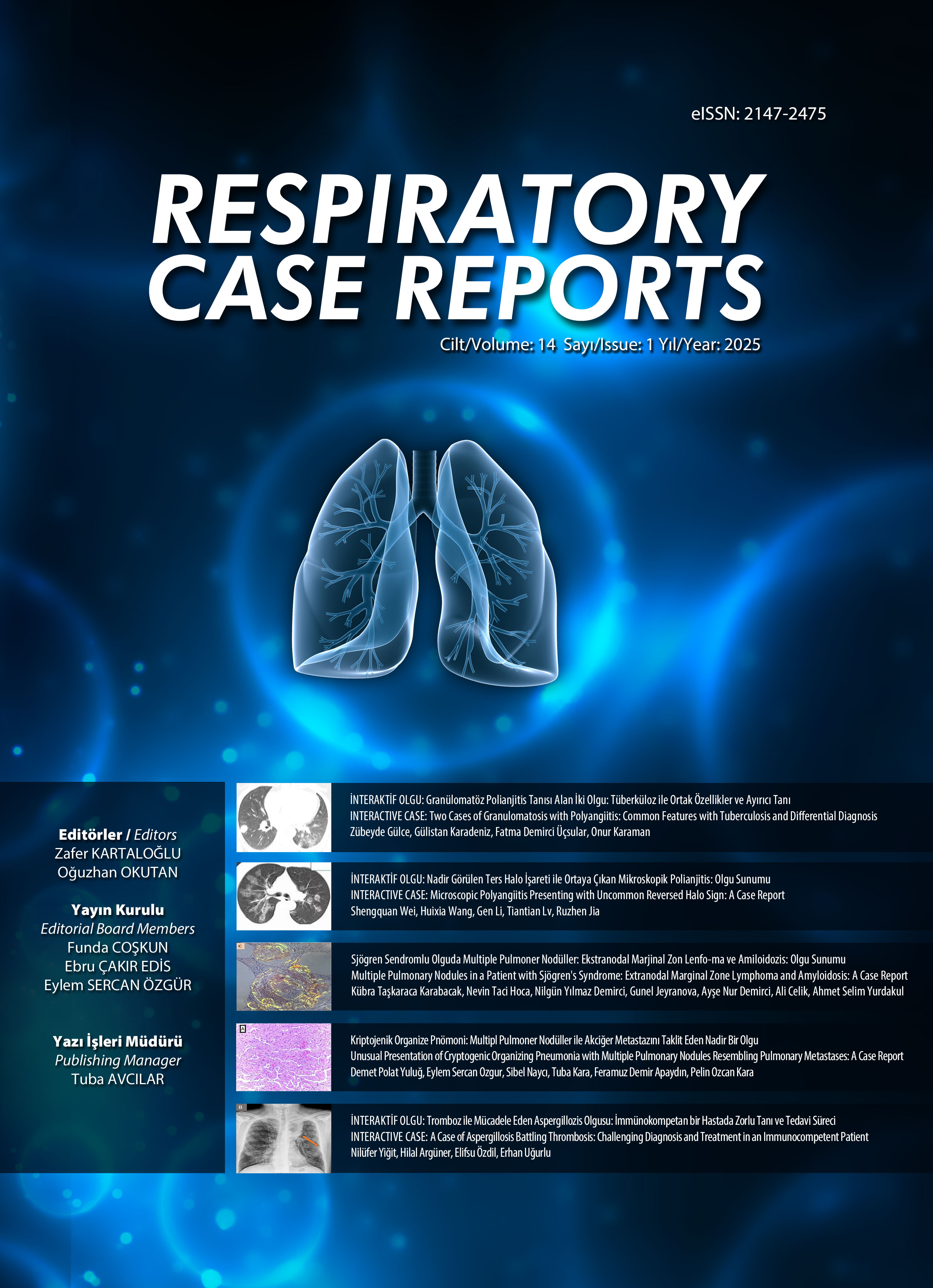e-ISSN 2147-2475

Volume: 3 Issue: 3 - October 2014
| COVER | |
| 1. | Cover Page I |
| EDITORIAL BOARD | |
| 2. | Editorial Board Page II |
| CASE REPORT | |
| 3. | A case of ARDS due to Legionella Pneumonia treated with ECMO Özlem Ediboğlu, Sami Cenk Kıraklı, Dursun Tatar, Fatma Fevziye Tuksavul doi: 10.5505/respircase.2014.60252 Pages 134 - 137 Acute respiratory distress syndrome (ARDS) is characterized by hypoxemic respiratory failure and bilateral radiographic infiltration. A 38-year-old female was admitted to the emergency room with coughing, sore throat, fever, and dyspnea for the last three days. The physical examination revealed that the patient had dyspnea, tachypnea, tachycardia, and crackles were heard on auscultation. The patients hemogram was normal, C-reactive protein was 30mg/dL, and procalcitonin was 19.8ng/mL. The patient had signs of hypoxemic respiratory failure in the arterial blood gas analysis. The chest x-ray showed bilateral alveolar opacities consistent with ARDS. The legionella antibody was positive in the urine sample. The patient was intubated due to unresponsiveness to non-invasive ventilation. Afterwards, extracorporeal membrane oxygenation (ECMO) was performed for six days. The patient was extubated on the seventh day. The case is presented because due to the novel use of ECMO for ARDS in our center. |
| 4. | Interstitial lung disease secondary to iron deposition in the lungs in a patient with hemosiderosis Elif Yılmazel Uçar, Metin Akgün, Ömer Araz, Ravza Bayraktar Barın, Elif Demirci, Fatih Alper doi: 10.5505/respircase.2014.41961 Pages 138 - 140 Hemosiderosis is the abnormal accumulation of iron in the parenchymal organs, leading to organ toxicity. It may be hereditary or caused secondary to diseases of erythropoiesis and the treatment of the diseases with blood transfusion. Herein, we present a case of thalassemia with blood transfusion, due to iron accumulation in the lungs. Interstitial lung disease secondary to this accumulation in a hemosiderosis case is extremely rare, and the study aimed to highlight the possibility of interstitial lung disease secondary to repeated blood transfusion by iron accumulation in the lungs. |
| 5. | Pulmonary Langerhans' Cell Histiocytosis: A Case Report Osman Hacıömeroğlu, Gülbanu Horzum Ekinci, Murat Kavas, Dilem Anıl Mavigök, Ayçim Şen, Adnan Yılmaz doi: 10.5505/respircase.2014.30932 Pages 141 - 144 A 43-year-old female was admitted with dyspnea. The postero-anterior chest x-ray revealed blunting of the left sinus and increased reticulonodular density in the bilateral lung parenchyma. High-resolution computed tomography demonstrated various diameters of cystic lesions throughout both lung fields with consolidations and scattered nodules. A wedge resection was performed by mini-thoracotomy. The histopathological diagnosis was pulmonary Langerhans cell histiocytosis. |
| 6. | A Case of Sarkoidosis that Developed Lupus Pernio Lesions in the Chronic Stage İlkin Zindancı, Hacer Kuzu Okur, Mukaddes Kavala, Ayşe Serap Karadağ, Zafer Turkoglu, Bengü Çobanoğlu Şimşek, Şeyma Özkanlı, Burçe Can doi: 10.5505/respircase.2014.51523 Pages 145 - 148 Sarcoidosis is a multisystem chronic disease that has an unknown etiology and is characterized by non-caseificating granulomas. Skin involvement is characterized by either specific lesions such as lupus pernio, infiltrating plaques, subcutaneous nodules, scaring and alopecia, or non-specific lesions of erythema nodosum. Skin involvement may be seen as the first symptom or can be seen during the later course of the disease. Specific skin lesions can be seen in the advanced stages of systemic sarcoidosis and have prognostic significance. The current study presents a case of advanced stage lung sarcoidosis that developed lupus pernio lesions in the chronic stage. |
| 7. | A Case Of Endobronchial Pulmonary Schwannoma Sinem Berik Safçi, Havva Erdem, Bekir Sami Polat, Cem Şahiner, Ömer Yazgan doi: 10.5505/respircase.2014.93695 Pages 149 - 152 A 21-year-old man with previous asthma diagnosis was admitted to our clinic due to dyspnea. An abnormality was observed on the cardiac borders in posteroanterior chest x-ray. Computed tomography of the thorax showed a 25X11 mm, lobulated, smooth-edged mass in the left main bronchus. The pulmonary function test indicated a restrictive pattern. A fiber-optic bronchoscopy was performed, indicating a polypoid endobronchial mass with a pedicle obstructing almost all the lumen of the left main bronchus, 1-2 cm away from the carina. The biopsy result from the lesion was consistent with schwannoma. Pulmonary schwannomas are rare and benign tumors and are derived from the nerve sheaths. The current study presents a case of endobronchial schwannoma associated with pectus excavatum |
| 8. | Endobronchial Polyp Ahmet Arisoy, Selami Ekin, Bülent Özbay, Erdoğan Çetinkaya, Akif Özgül doi: 10.5505/respircase.2014.87487 Pages 153 - 155 Pulmonary benign tumors are quite rare neoplasms. They can cause chronic cough, shortness of breath, and obstructive pneumonias. They may not be detected by chest x- ray or computed tomography of thorax. The current study presents the case of a 65-year-old male patient and his clinical problems, computed tomography findings, bronchoscopic images, and treatment. |
| 9. | A rare cause of posterior mediastinal masses: extramedullary hematopoiesis (two cases) Levent Özdemir, Burcu Özdemir, Suat Durkaya, Cansu Topal, Sema Nur Çalışkan, Ali Ersoy, Gökhan Büyükbayram, Zulal Özbolat doi: 10.5505/respircase.2014.63835 Pages 156 - 158 Extramedullary hematopoiesis is the production of blood cells, except for bone marrow, and a compensatory mechanism for a variety of hematologic disorders such as thalassemia, sickle cell anemia, and myelofibrosis. It is rarely seen in the region of the thorax. One 24-year-old and one 34-year-old male patient were examined due to homogeneous opacities that not obliterated the heart border in the chest radiograph. Both patients had a history of thalassemia intermedia. The physical examination was unremarkable, except for sclera, jaundice, and hepatomegaly. On computed tomography, bilateral paravertebral homogenous soft tissue density areas in the posterior mediastinum were detected. These mass lesions were accepted as extramedullary hematopoiesis. Symmetrical posterior mediastinal masses should be considered in the differential diagnosis of extramedullary hematopoiesis and hematologic diseases. |
| 10. | Tracheal rupture in a farmer developed by a neck tie Muhammet Sayan, Ali Çelik, Abdullah İrfan Taştepe doi: 10.5505/respircase.2014.52244 Pages 159 - 162 Tracheobronchial rupture is rare and a life threatening injury. Clinical presentations vary as to whether peribronchial tissues remain intact or not. A 30-year-old farmer was evaluated with dyspnea and neck swelling after a work accident due to a neck tie. The patient who was diagnosed with tracheal rupture underwent tracheal resection and reconstruction. He was discharged seven days after the operation. At the 12-month follow-up, the bronchoscopy showed good patency over the anastomotic region. |
| 11. | Pneumomediastinum Following Tonsillectomy: A Rare Complication Nuri Düzgün, Hıdır Esme, Gültekin Övet, Mustafa Çalık, Ercan Kurtipek doi: 10.5505/respircase.2014.03016 Pages 163 - 165 Pneumomediastinum is rarely observed sequelae of surgical interventions in the upper aerodigestive tract. Pneumomediastinum was first described by Laennec in 1819 as a consequence of traumatic injury. Symptoms include chest pain, neck pain, dyspnea, and odynophagia. The events leading to subcutaneous emphysema and mediastinitis have not been entirely clarified. They likely include the direct introduction of air into the neck via either the tonsillar bed or a laryngeal or pharyngeal wound caused by intubation. In the current study, post-tonsillectomy operation dyspnea, chest pain, the development of mediastinal emphysema, and computed tomography identified common clinical and treatment process will be presented. |
| 12. | Intrapulmonary solitary fibrous tumor Celal Bugra Sezen, Ali Çelik, Süleyman Anıl Akboğa, Nalan Akyürek, Abdullah İrfan Taştepe doi: 10.5505/respircase.2014.44154 Pages 166 - 168 Solitary fibrous tumors (SFT) are a rare tumor that frequently occurs in the pleural space, but intrapulmonary SFT is very seldom. A 75-year-old female was admitted to our clinic with dyspnea. The chest tomography showed an intrapulmonary lesion in the left lower lobe of the lung. A left lower lobectomy was performed. The pathological diagnosis was obtained by specific markers including CD34, vimentin, and BCL2. The present study presents a rare case of an entirety intrapulmonary localized fibrous tumor of the lung. |
| 13. | An Extraordinary Case Of Intrathoracic Extrapulmonary Hydatid Cyst Halil Tözüm, Haydar Yalman, Canan Eren, Salih Bölük, Tahir Şevval Eren doi: 10.5505/respircase.2014.46320 Pages 169 - 172 A 24-year-old male, who had a history of left lower lobectomy and splenectomy due to hydatid cyst 12 years ago, applied to our clinic with a severe pain localized in the left hemithorax that had continued for approximately six months. Radiological studies displayed interesting images resembling a bunch of grapes. An exploratory thoracotomy was performed with an initial diagnosis of recurrent hydatid cyst. Beneath the left upper lobe, a giant pleural pouch with tight adhesions extending to the diaphragm was present. Inside the pouch, hundreds of daughter cysts were observed. In the middle of the diaphragm there was a dissolved area and with an opening from this point, a similar pouch located at the retroperitoneal space was found. With a transdiaphragmatic approach, both pouches were drained and cleaned appropriately. At the 16th month of postoperative follow-up, patient had no complaints. |
| 14. | A case of cavitary lung tuberculosis admitted with loss of hearing Savaş Gegin, Deniz Çelik, Gülay Dede, Mesut Subak doi: 10.5505/respircase.2014.57441 Pages 173 - 176 Tuberculosis is an infectious disease that is frequently seen in developing countries. The disease has the potential to involve all systems and organs: however, it usually causes lung infection. Upper respiratory tract involvement is a rare form of the disease and occurs in approximately 1.8% of all tuberculosis cases. Hearing loss is not a common symptom in tuberculosis infections. Middle ear, nasopharynx, and larynx involvement is related to this symptom. A 24-year-old male patient was admitted to otolaryngology clinic with symptoms of hoarseness and loss of hearing. A biopsy of the nasopharynx revealed granulomatous inflammation and the patient was referred to our clinic. The chest x-ray revealed cavitary lesions. Upon further examination, the patient was diagnosed with lung and nasopharyngeal tuberculosis and treated. After the treatment, all symptoms and radiological findings significantly improved. The current cavitary lung tuberculosis case is presented due to the nature of rare symptoms, including loss of hearing caused by nasopharyngeal tuberculosis. |
| 15. | Endobronhial Tuberculosis: A report of Three Cases Gülbanu Horzum Ekinci, Osman Hacıömeroğlu, Murat Kavas, Adnan Yılmaz doi: 10.5505/respircase.2014.30301 Pages 177 - 181 The researchers of the current study aimed to evaluate the clinical, radiological, and bronchoscopic findings, and the therapeutic outcome of the disease in three patients with endobronchial tuberculosis (EBTB). Two females and one male were included in the study, and their ages were younger than 45 years. Computed tomography of the thorax showed cavity in one patient, a mass lesion and atelectasis in one patient, and multiple parenchymal nodules and enlargement mediastinal lymph nodes in the other patient. Smear examinations of sputum samples were negative for acid-fast-bacilli in all patients. Flexible bronchoscopy revealed microbial and histopathological diagnosis of endobronchial tuberculosis in three patients. While the bronchial lavage smear was positive for acid-fast-bacilli in two cases, the culture examination for tuberculosis bacilli was positive in all patients. The patients were started on anti-tuberculosis treatment. Bronchoscopy was repeated after treatment and revealed complete resolution of the endobronchial lesions in the patients. In conclusion, the eradication of tubercle bacilli and prevention of bronchostenosis are two important goals of EBTB treatment. Early diagnosis and effective treatment of this disease are required to achieve these objectives. |
| 16. | Lung metastasis of malignant melanoma with unknown primary origin Haşim Boyacı, Serap Argun Barış, Tuğba Aşlı Önyılmaz, Kürşat Yıldız, Yusuf Taha Güllü, İlknur Başyiğit, Füsun Yıldız doi: 10.5505/respircase.2014.42204 Pages 182 - 185 Malignant melanoma is a malignant tumor with increasing prevalence worldwide. However, metastatic malignant melanoma with unknown primary origin is rarely seen. The current study presents a case with bilaterally multiple nodules in pulmonary parenchyma in which no primary malignant site was found, despite detailed screening and diagnosed as metastasis of malignant melanoma by surgical lung biopsy. The current case is presented as a reminder that malignant melanoma should be kept in mind in metastatic lung lesions with unknown primary origin. |
| 17. | A case of small cell lung cancer associated with invasive zygomycosis Evrim Eylem Akpınar, Derya Hoşgün, Başar Kaya, Hande Ezeraslan, Semra Tunçbilek, Handan Doğan, Meral Gülhan doi: 10.5505/respircase.2014.86580 Pages 186 - 190 Zygomycosis is an invasive fungal infection with a progressive clinical course and commonly concluding with mortality. Diabetes mellitus and malignant hematological diseases are the most common predisposing risk factors. It is rarely associated with solid tumors. Concomitant chemoradiotherapy had been applied to the presented patient with the diagnosis of limited small cell lung cancer. He had diabetes mellitus and was using dexamethasone for radiation esophagitis. He admitted with the complaint of periorbital pain after the third cycle of chemotherapy. Palatal necrosis was detected and a biopsy was taken from the lesion. Branching hyphae were observed on the microscopic evaluation and Rhizomucor spp. proliferated on culture. He was diagnosed with invasive zygomycosis and was treated with combined systemic antifungal treatment and topical antifungal in addition to surgical debridement, which resulted in near-complete healing. The aim of this report was to emphasize the clinical importance of invasive zygomycosis, which is rarely seen with solid tumors by presenting a case that had a favorable clinical course by means of combined systemic antifungal treatment and surgical debridement. |
| AUTHOR INDEX | |
| 18. | Author Index Pages 191 - 192 Abstract | |
| REVIEWER INDEX | |
| 19. | Rewiever Index Page 193 Abstract | |











